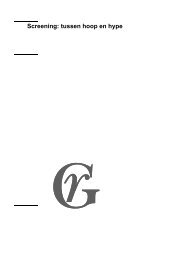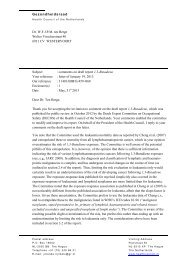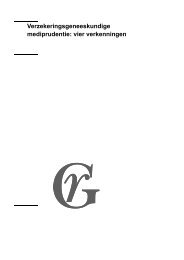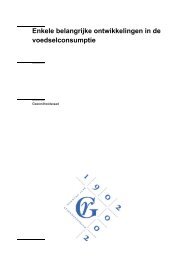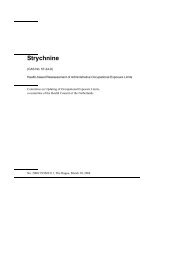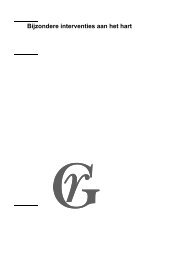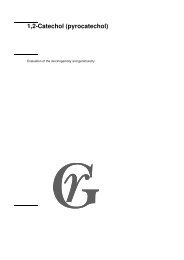Health Council of the Netherlands Reports 2003 - Gezondheidsraad
Health Council of the Netherlands Reports 2003 - Gezondheidsraad
Health Council of the Netherlands Reports 2003 - Gezondheidsraad
You also want an ePaper? Increase the reach of your titles
YUMPU automatically turns print PDFs into web optimized ePapers that Google loves.
Incidence <strong>of</strong> brain injury<br />
Not a great deal is known about <strong>the</strong> prevalence <strong>of</strong> brain injury in boxing or o<strong>the</strong>r<br />
fighting sports. Given that inflicting brain injury is one <strong>of</strong> <strong>the</strong> intrinsic aims <strong>of</strong><br />
boxing in particular, little or no research has been conducted into <strong>the</strong> prevention<br />
<strong>of</strong> such injuries. No attempt has ever been made to quantify <strong>the</strong> incidence <strong>of</strong><br />
acute brain injury in pr<strong>of</strong>essional boxers. However, studies showed that one in<br />
eight amateur contests ends in concussion. Information from <strong>the</strong> Amateur<br />
International Boxing Association (AIBA) indicates that <strong>the</strong> percentage <strong>of</strong><br />
contests at world championship and Olympic tournaments stopped because <strong>of</strong><br />
brain injury has declined in recent decades, from about 10 per cent to no more<br />
than 3 per cent. This may indicate a fall in <strong>the</strong> incidence <strong>of</strong> concussion at such<br />
tournaments, but this possibility has not been investigated. It has been<br />
convincingly demonstrated that between 40 and 80 per cent <strong>of</strong> pr<strong>of</strong>essional<br />
boxers suffer chronic brain injury. The seriousness <strong>of</strong> <strong>the</strong> abnormalities appears<br />
to be related to <strong>the</strong> number <strong>of</strong> bouts. Amateur boxers are also affected by chronic<br />
brain injury, but no data on <strong>the</strong> incidence is available and <strong>the</strong> evidence suggests<br />
that <strong>the</strong> problem is much less serious than among pr<strong>of</strong>essional boxers.<br />
With regard to soccer, <strong>the</strong> most informative research data indicates that <strong>the</strong>re<br />
are six cases <strong>of</strong> concussion in every ten thousand men’s matches/training<br />
sessions, and four cases in every ten thousand women’s matches/training<br />
sessions. The average player has about a 50 per cent chance <strong>of</strong> suffering<br />
concussion at some point in his/her playing career. There is no evidence to<br />
suggest that heading <strong>the</strong> ball can cause concussion. The Committee knows <strong>of</strong><br />
only one study reported to date that looked at <strong>the</strong> subject <strong>of</strong> chronic brain injury<br />
in ex-pr<strong>of</strong>essional soccer players. Neuropsychological tests indicated that eight<br />
<strong>of</strong> <strong>the</strong> ten former players participating exhibited abnormalities (albeit mild in<br />
some cases). It is not clear to what extent <strong>the</strong> subjects are comparable with<br />
modern-day players, since various aspects <strong>of</strong> <strong>the</strong> game have changed over <strong>the</strong><br />
years. Studies involving active soccer players have produced mixed findings;<br />
some have suggested that soccer is associated with chronic brain injury, while<br />
o<strong>the</strong>rs have found no link. Notably, chronic injury has been observed only in<br />
players who have executed more than a thousand headers.<br />
The interpretation <strong>of</strong> data on sports-related brain injuries is complicated by<br />
significant inter-study inconsistency in <strong>the</strong> definition <strong>of</strong> acute and chronic brain<br />
injury. In fact, <strong>the</strong> findings <strong>of</strong> <strong>the</strong> studies reported to date cannot properly be<br />
compared. If insight into <strong>the</strong> incidence <strong>of</strong> acute and chronic sports-related brain<br />
10 <strong>Health</strong> <strong>Council</strong> <strong>of</strong> <strong>the</strong> Ne<strong>the</strong>rlands; <strong>Reports</strong> <strong>2003</strong>



